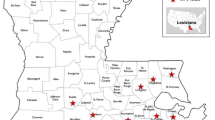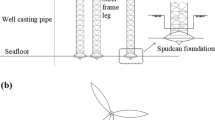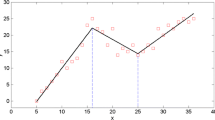Abstract
The novel equation for determining the stability number of unsupported conical slopes in anisotropic and heterogeneous clays is presented in this study. Multivariate Adaptive Regression Splines (MARS) model ~ a machine learning approach, is adopted to build the close–form equation between input variables and output results, and also investigate the coupling effects among input variables by sensitive analysis. The artificial data for MARS model is 576 combinations of four input variables (i.e., the ratio between the height and the radius at the bottom slope, and the inclination angle of slope, the gradient of increasing undrained shear strength, ratio of anisotropic) corresponding to output results of stability number which is based on finite element limit analysis (FELA) results from a previous study. The results of the paper provide a guidance theory and effective tool for practical engineering in determining the stability number of unsupported conical slopes in anisotropic and heterogeneous clays.
Access this chapter
Tax calculation will be finalised at checkout
Purchases are for personal use only
Similar content being viewed by others
References
Britto, A.M., Kusakabe, O.: Stability of unsupported axisymmetric excavation in soft clay. Geotechnique 32(3), 261–270 (1982)
Pastor, J., Turgeman, S.: Limit analysis in axisymmetrical problems Numerical determination of complete statistical solutions. Int. J. Mech. Sci. 24(2), 95–117 (1982)
Lyamin, A.V., Sloan, S.W.: Lower bound limit analysis using non-linear programming. Int. J. Numer. Meth. Eng. 55, 573–611 (2002)
Kumar, J., Chakraborty, D.: s for an unsupported vertical circular excavation in c- soil. Comput. Geotech. 39, 79–84 (2012)
Kumar, J., Chakraborty, M., Sahoo, J.P.: Stability of unsupported vertical circular excavations. J. Geotech. Geoenvironmental Eng. 140(7), 04014028 (2014)
Huynh, Q.T., Lai, V.Q., Shiau, J., Keawsawasvong, S., Mase, L.Z., Tra, H.T.: On the use of both diaphragm and secant pile walls for a basement upgrade project in Vietnam. Innov. Infrastruct. Solut. 7(1), 1 (2021). https://doi.org/10.1007/s41062-021-00625-7
Huynh, Q.T., Lai, V.Q., Boonyatee, T., Keawsawasvong, S.: Verification of soil parameters of hardening soil model with small-strain stiffness for deep excavations in medium dense sand in Ho Chi Minh City, Vietnam. Innov. Infrastruct. Solut. 7(1), 1–20 (2022)
Huynh, Q.T., Lai, V.Q., Boonyatee, T., Keawsawasvong, S.: Behavior of a deep excavation and damages on adjacent buildings: a case study in Vietnam. Transp. Infrastruct. Geotechnol. 8(3), 361–389 (2021)
Lai, V.Q., Le, M.N., Huynh, Q.T., Do, T.H.: 2020: Performance analysis of a combination between D-wall and Secant pile wall in upgrading the depth of basement by Plaxis 2D: a case study in Ho Chi Minh city. In: ICSCEA 2019, pp. 745–755. Springer, Singapore (2019)
Huynh, Q.T., Lai, V.Q., Tran, V.T. and Nguyen, M.T.: Back analysis on deep excavation in the thick sand layer by hardening soil small model. In: ICSCEA 2019, pp. 659–668. Springer, Singapore (2019)
Keawsawasvong, S., Ukritchon, B.: Stability of unsupported conical excavations in non-homogeneous clays. Comput. Geotech. 81, 125–136 (2017)
Ukritchon, B., Keawsawasvong, S.: A new design equation for drained stability of conical slopes in cohesive-frictional soils. J. Rock Mech. Geotech. Eng. 10(2), 358–366 (2018)
Yodsomjai, W., Keawsawasvong, S., Likitlersuang, S.: Stability of unsupported conical slopes in Hoek-Brown rock masses. Transp. Infrastruct. Geotech. (2020)
Yodsomjai, W., Keawsawasvong, S., Thongchom, C., Lawongkerd, J.: Undrained stability of unsupported conical slopes in two-layered clays. Innov. Infrastruct. Solut. 6(1), 1–17 (2020). https://doi.org/10.1007/s41062-020-00384-x
Keawsawasvong, S., Lai, V.Q.: End bearing capacity factor for annular foundations embedded in clay considering the effect of the adhesion factor. Int. J. Geosynth. Ground Eng. 7(1), 1 (2021)
Ukritchon, B., Keawsawasvong, S.: Undrained stability of unlined square tunnels in clays with linearly increasing anisotropic shear strength. Geotech. Geol. Eng. 38(1), 897–915 (2020)
Ukritchon, B., Yoang, S., Keawsawasvong, S.: Undrained stability of unsupported rectangular excavations in non-homogeneous clays. Comput. Geotech. 117, 103281 (2020)
Casagrande, A., Carillo, N.: Shear failure of anisotropic soils. Contrib. Soil Mech. (BSCE) 1941–1953(4), 122–135 (1994)
Lo, K.Y.: Stability of slopes in anisotropic soils. J. Soil Mech. Found. Division 31, 85–106 (1965)
Davis, E.H., Christian, J.T.: Bearing capacity of anisotropic cohesive soil. J. Soil Mech. Found. Division 97(5), 753–769 (1971)
Krabbenhoft, K., Lyamin, A.V.: Generalised Tresca criterion for undrained total stress analysis. Geotech. Lett. 5, 313–317 (2015)
Krabbenhøft, K., Galindo-Torres, S.A., Zhang, X., Krabbenhøft, J.: AUS: Anisotropic undrained shear strength model for clays. Int. J. Numer. Anal. Meth. Geomech. 43(17), 2652–2666 (2019)
Nguyen, D.K., Nguyen, T.P., Keawsawasvong, S., Lai, V.Q.: Vertical uplift capacity of circular anchors in clay by considering anisotropy and non-homogeneity. Transp. Infrastruct. Geotechnol. (2021)
Lai, V.Q., Nguyen, D.K., Banyong, R., Keawsawasvong, S.: Limit analysis solutions for stability number of unsupported conical slopes in clays with heterogeneity and anisotropy. Int. J. Comput. Mater. Sci. Eng. 2150030 (2021)
Sirimontree, S., et al.: Prediction of penetration resistance of a spherical penetrometer in clay using multivariate adaptive regression splines model. Sustainability 14(6), 3222 (2022)
Keawsawasvong, S., Shiau, J., Ngamkhanong, C., Lai, V.Q., Thongchom, C.: Undrained stability of ring foundations: axisymmetry, anisotropy, and nonhomogeneity. Int. J. Geomech. 22(1), 04021253 (2022)
Lai, V.Q., Banyong, R., Keawsawasvong, S.: Stability of limiting pressure behind soil gaps in contiguous pile walls in anisotropic clays. Eng. Failure Anal. 106049 (2022)
Keawsawasvong, S., Seehavong, S., Ngamkhanong, C.: Application of artificial neural networks for predicting the stability of rectangular tunnels in hoek-brown rock masses. Front. Built Environ 8, 837745 (2022)
Lai V.Q., Shiau, J., Keawsawasvong, S., Tran, D.T.: Bearing capacity of ring foundations on anisotropic and heterogenous clays ~ FEA, NGI-ADP, and MARS. Geotech. Geol. Eng. (2022). https://doi.org/10.1007/s10706-022-02117-6
Butterfield, R.: Dimensional analysis for geotechnical engineering. Géotechnique 49(2), 357–366 (1999)
Friedman, J.H.: Multivariate adaptive regression splines. Ann. Stat 19, 1–67 (1991)
Yang, C.-C., Prasher, S.O., Lacroix, R., Kim, S.H.: Application of multivariate adaptive regression splines (MARS) to simulate soil temperature. Trans. ASAE 47(3), 881 (2004)
Deo, R.C., Kisi, O., Singh, V.P.: Drought forecasting in eastern Australia using multivariate adaptive regression spline, least square support vector machine and M5Tree model. Atmos. Res. 184, 149–175 (2017)
Lai, F., Zhang, N., Liu, S., Sun, Y., Li, Y.: Ground movements induced by installation of twin large diameter deeply-buried caissons: 3D numerical modeling. Acta Geotech. 16(9), 2933–2961 (2021). https://doi.org/10.1007/s11440-021-01165-1
Zhang, W., Zhang, R., Wang, W., Zhang, F., Goh, A.T.C.: A multivariate adaptive regression splines model for determining horizontal wall deflection envelope for braced excavations in clays. Tunn. Undergr. Space Technol 84, 461–471 (2019)
Wu, L., Fan, J.: Comparison of neuron-based, kernel-based, tree-based and curve-based machine learning models for predicting daily reference evapotranspiration. PLoS ONE 14, e0217520 (2019)
Raja, M.N.A., Shukla, S.K.: Multivariate adaptive regression splines model for reinforced soil foundations. Geosynth. Int 28, 368–390 (2021)
Caraka, R.E., Chen, R.C., Bakar, S.A., Tahmid, M., Toharudin, T., Pardamean, B.: Employing best input SVR robust lost function with nature-inspired metaheuristics in wind speed energy forecasting. IAENG Int. J. Comput. Sci. 2020(47), 572–584 (2020)
Jearsiripongkul, T., Lai, V.Q., Keawsawasvong, S., Nguyen, T.S., Nguyen Van, C., Thongchom, C., Nuaklong, P.: Prediction of uplift capacity of cylindrical caissons in anisotropic and inhomogeneous clays using multivariate adaptive regression splines. Sustainability 14, 4456 (2022). https://doi.org/10.3390/su14084456
Lai, V.Q., Banyong, R., Keawsawasvong, S.: Undrained sinkhole collapse in anisotropic clays. Arab. J. Geosci. 15(8), 1–13 (2022). https://doi.org/10.1007/s12517-022-10061-1
Yodsomjai, W., Lai, V.Q., Banyong, R., Chauhan, V.B., Thongchom, C., Keawsawasvong, S.: A machine learning regression approach for predicting basal heave stability of braced excavation in non-homogeneous clay. Arab. J. Geosci. 15(9), 1–14 (2022)
Shiau, J., Lai, V.Q., Keawsawasvong, S.: Multivariate adaptive regression splines analysis for 3D slope stability in anisotropic and heterogenous clay. J. Rock Mech. Geotech. Eng. Accepted
Acknowledgement
We would like to thank Ho Chi Minh City University of Technology (HCMUT), VNU-HCM for the support of time and facilities for this study.
Author information
Authors and Affiliations
Corresponding author
Editor information
Editors and Affiliations
Rights and permissions
Copyright information
© 2023 The Author(s), under exclusive license to Springer Nature Switzerland AG
About this paper
Cite this paper
Lai, V.Q., Thongchom, C., Keawsawasvong, S., Van, C.N. (2023). Multivariate Adaptive Regression Splines for Stability Number of Unsupported Conical Slopes in Anisotropic and Heterogeneous Clays. In: Huang, YP., Wang, WJ., Quoc, H.A., Le, HG., Quach, HN. (eds) Computational Intelligence Methods for Green Technology and Sustainable Development. GTSD 2022. Lecture Notes in Networks and Systems, vol 567. Springer, Cham. https://doi.org/10.1007/978-3-031-19694-2_15
Download citation
DOI: https://doi.org/10.1007/978-3-031-19694-2_15
Published:
Publisher Name: Springer, Cham
Print ISBN: 978-3-031-19693-5
Online ISBN: 978-3-031-19694-2
eBook Packages: Intelligent Technologies and RoboticsIntelligent Technologies and Robotics (R0)




